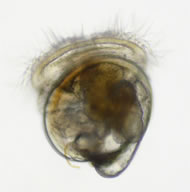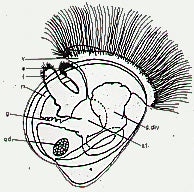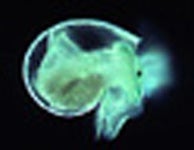
Worldwide, one of the largest yields in marine aquaculture for an individual species is from the Pacific cupped oyster, Crassostrea gigas. Global oyster production is over 4 million metric tonnes grown per year.

Photo and diagram of a larval stage of the Pacific oyster, C. gigas. Our work with these larval forms includes:
1. Studies of nutrient uptake from seawater by bacteria-free (“axenic”) larvae (Manahan, 1989; 1990)
2. Studies of the nutritional requirements of larvae (Welborn and Manahan, 1995)
3. The physiological bases of growth and hybrid vigor (Pace et al., 2006; Meyer and Manahan, 2010).

This photo shows the veliger-stage larva of the red abalone, Haliotis rufescens. This larval form was raised in the laboratory from a fertilized egg. These larvae are non-feeding during development.
We have investigated the energy metabolism of this species during larval development (Jaeckle & Manahan, 1989; Moran and Manahan, 2003) and during metamorphosis (Shilling et al., 1996).
Contact Details
Professor Donal T. Manahan
Department of Biological Sciences
USC Dornsife College of Letters, Arts and Sciences
University of Southern California
Los Angeles, CA 90089-0371
